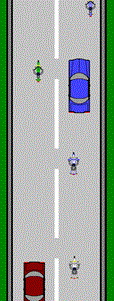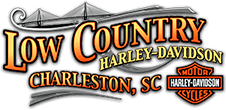Low Country Harley-Davidson® H.O.G.® Safety
Hand Signals

When riding in a group it is very important to know and understand hand signals. Below are animated examples of hand signals recognized by the industry. Hand signals should be passed from the front to the rear of the riding group to ensure the safe movement of the group.
Wind Chill Chart


Riding Preparation
Depending on the type of group ride and other variables, Charleston H.O.G.® may sometimes try to limit the size of a group to 15 bikes for safety reasons. If there are more than 15 bikes and we have chosen to break up into smaller groups, we will line up in two or more columns as indicated in columns A, B, & C in the picture to the right. Column A will depart first. A few minutes later column B will leave and then column C.
If you want to ride with friends, you must all be in the same column. If you are in different columns, you will not ride in the same group.
You should talk to one of the leaders and learn the route and destination of your ride. In the unlikely event that you get separated from the group, all will not be lost and you can catch up or meet the group at the destination.
Important!
- Be prepared to ride at the specified departure time with a full tank of gas and an empty bladder.
- If you have special needs or concerns be sure to tell the leader of your group. Lesser experienced riders should be at the front of the group behind the group leader, not at the back. The back of the group is constantly exposed to a slinky or whiplash effect and is most likely to be separated from the group at intersections.
- If you plan on dropping out during the ride, please tell the group leader. It is inconsiderate to the whole group if they have to look for you, only to find out that you went home.

Staggered Formation
Low Country Charleston, SC Chapter, will always ride in a staggered formation for safety reasons.
The minimum recommended spacing to the bike directly in front of you should not be less than two seconds (the two second rule). The bike in the lane to your left or right should not be less than one second ahead of you. You will find that two seconds is a long distance when riding at highway speeds. That is it's a long distance when everything is going well. When things go wrong, however, two seconds distance is gone in the time it takes to figure out you are in trouble.
The two second rule is a rule of thumb should try to adhere to this rule when possible, especially at highway speeds. There are times, however when it is best to squeeze together while in city streets & while slowing for a stop. This will help prevent cars from entering the group.
The last bike should ride in the middle of the two bike lanes with all head lights and running lights on. This will help the lead bike see the last bike.

Fast Lane Passing
As a group, it can be difficult to pass a slow moving car on any road with two or more lanes of same-direction traffic. This is especially true with moderate to heavy traffic. Often there is not enough room for the entire group to get between cars in the faster lane.
The way to accomplish this is for the last bike to pull over one lane to the left and hold his position. Each rider should move to the left lane as the cars in front of the rear biker pass them. You can then pass the slow car as a group after the lead rider moves to the left lane.
The lead rider should move back to the right lane after passing the slow car by a safe distance. It is very important that the lead rider maintain speed to make room for all the other riders. Each rider should move back to the right lane one at a time once safely cleared the slow car.
This can be a real slick choreographed move for other motorists to observe.

Two Lane Passing
It is usually very difficult for a group to pass a slow moving car on a two lane road. Generally Charleston H.O.G.® will not pass a car on a two lane road, particularly on local rides, unless it is going very slow. If the lead biker decides to pass the car, each biker must decide on his own if it is safe for him or her. Do not follow the bike in front of you unless you are certain that it is safe for you too.
Important: After passing the car, keep going. You must make room for all the bikes behind you.
